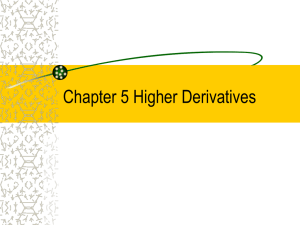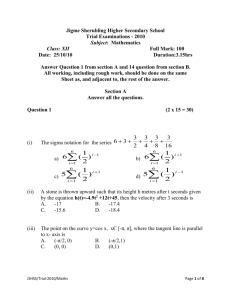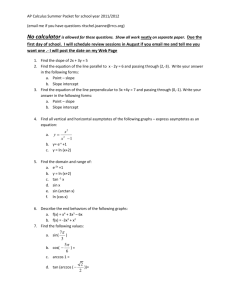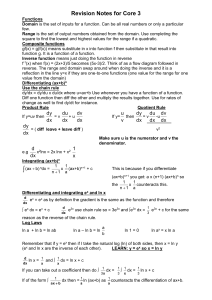AMS 361- Applied Calculus IV Homework 6
advertisement
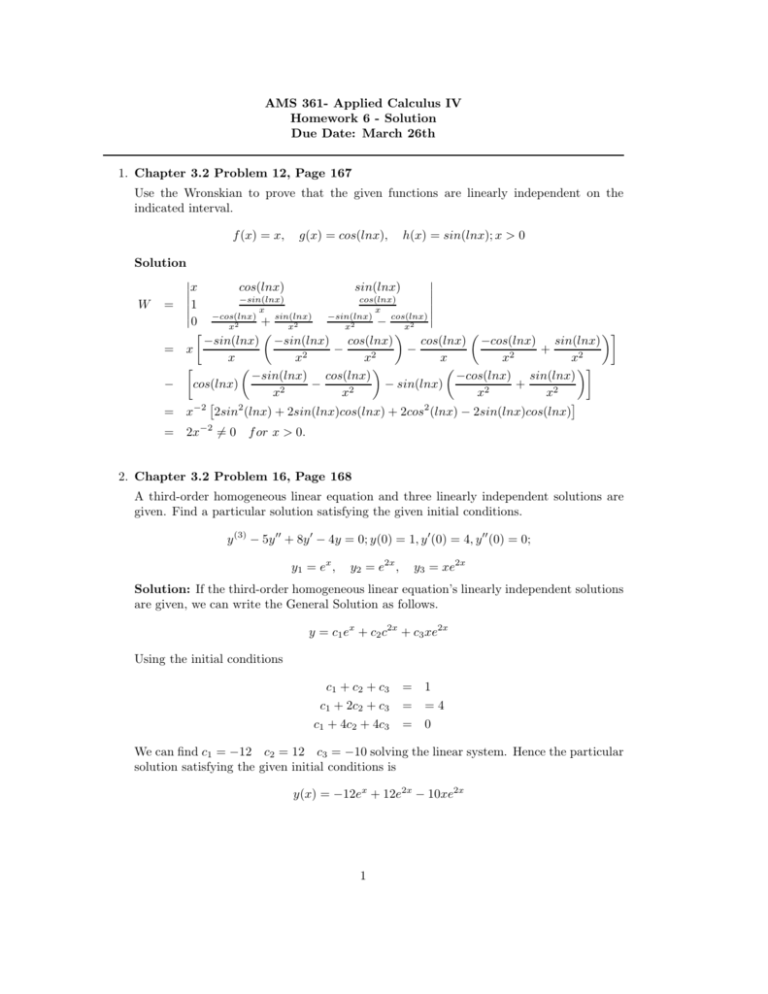
AMS 361- Applied Calculus IV Homework 6 - Solution Due Date: March 26th 1. Chapter 3.2 Problem 12, Page 167 Use the Wronskian to prove that the given functions are linearly independent on the indicated interval. f (x) = x, g(x) = cos(lnx), h(x) = sin(lnx); x > 0 Solution x cos(lnx) sin(lnx) −sin(lnx) cos(lnx) W = 1 x x 0 −cos(lnx) + sin(lnx) −sin(lnx) − cos(lnx) x2 x2 x2 x2 −sin(lnx) −sin(lnx) cos(lnx) cos(lnx) −cos(lnx) sin(lnx) = x − − + x x2 x2 x x2 x2 −cos(lnx) sin(lnx) −sin(lnx) cos(lnx) − sin(lnx) − + − cos(lnx) x2 x2 x2 x2 −2 2 2 = x 2sin (lnx) + 2sin(lnx)cos(lnx) + 2cos (lnx) − 2sin(lnx)cos(lnx) = 2x−2 6= 0 f or x > 0. 2. Chapter 3.2 Problem 16, Page 168 A third-order homogeneous linear equation and three linearly independent solutions are given. Find a particular solution satisfying the given initial conditions. y (3) − 5y ′′ + 8y ′ − 4y = 0; y(0) = 1, y ′ (0) = 4, y ′′ (0) = 0; y1 = ex , y2 = e2x , y3 = xe2x Solution: If the third-order homogeneous linear equation’s linearly independent solutions are given, we can write the General Solution as follows. y = c1 ex + c2 c2x + c3 xe2x Using the initial conditions c1 + c2 + c3 c1 + 2c2 + c3 c1 + 4c2 + 4c3 = 1 = =4 = 0 We can find c1 = −12 c2 = 12 c3 = −10 solving the linear system. Hence the particular solution satisfying the given initial conditions is y(x) = −12ex + 12e2x − 10xe2x 1 3. Chapter 3.2 Problem 22, Page 168 A nonhomogeneous differential equation, a complementary solution yc and particular solution yp are given. Find the solution satisfying the given initial conditions. y ′′ − 4y = 12; y(0) = 0, y ′ (0) = 10; yc = c1 e2x + c2 e−2x , yp = −3 Solution: Genereal solution of the nonhonogeneous DE is y(x) = yc + yp . y(x) = c1 e2x + c2 e−2x − 3 The general solution should satisfy the initial conditions y(0) = 0 = c1 + c2 − 3 y (0) = 10 = 2c1 − 2c2 ′ We can find c1 = 4, c2 = −1 solving the linear system. Hence the solution satisfying the given initial conditions is y(x) = 4e2x − e−2x − 3 4. Chapter 3.2 Problem 26, Page 168 (a) Find by inspection particular solutions of the two nonhomogeneous equations y ′′ + 2y = 4 and y ′′ + 2y = 6x (b) Use the method of problem 25 to find a particular solution of the differential equation y ′′ + 2y = 6x + 4. Solution: (a) Let y1 = c1 is the solution of y ′′ + 2y = 4 and y2 = c2 x + c3 is the solution of y ′′ + 2y = 6x y1′ = y1′′ = 0 ⇒ 2c1 = 4 ⇒ y1 = 2 y2′ = c2 , y2′′ = 0 ⇒ 2y2 = 6x ⇒ c2 = 3; c3 = 0 ⇒ y2 = 3x (b) y = y1 + y2 = 3x + 2 is the particular solution of the differential equation y ′′ + 2y = 6x + 4 where y ′′ = 0. 5. Chapter 3.2 Problem 33, Page 168 Suppose that the three numbers r1 , r2 and r3 are distinct. Show that the three functions exp(r1 x), exp(r2 x) and exp(r3 x) are linearly independent by showing that their Wronskian is nonzero for all x. Solution: The Wronskian of three functions is rx e1 e r2 x er3 x rx r2 er2 x r3 er3 x W = r1 e 1 r12 er1 x r22 er2 x r32 er3 x 1 1 1 = er1 x er2 x er3 x r1 r2 r3 r12 r22 r32 = er1 x er2 x er3 x r2 r32 − r3 r22 − (r1 r32 − r3 r12 ) + r1 r22 − r2 r12 = er1 x er2 x er3 x [r2 r3 (r3 − r2 ) − r1 r3 (r3 − r1 ) + r1 r2 (r2 − r1 )] 6= 0 f or r1 6= r2 6= r3 2 6. Chapter 3.2 Problem 38, Page 168 Use the method of reduction of order as in Problem 37 to find a second linearly independent solution y2 . x2 y ′′ + xy ′ − 9y = 0 (x > 0); y1 (x) = x3 Solution: The method of resuction of order y(x) y ′ (x) = v(x)x3 = v ′ (x)x3 + 3v(x)x2 y ′′ (x) = v ′′ (x)x3 + 6v ′ (x)x2 + 6v(x)x The given differential equation transforms into x2 v ′′ (x)x3 + 6v ′ (x)x2 + 6v(x)x + x v ′ (x)x3 + 3v(x)x2 − 9v(x)x3 = 0 After simplification v ′′ x5 + 7v ′ x4 = 0 Reducible second order differential equation (chapter1.6). Let v ′ = p xp′ + 7p = 0 ⇒ dp −7 = p x Integrating the both sides gives us lnp = −7lnx + lnc1 ⇒ p = c1 x−7 p = v ′ = c1 x−7 ⇒ v(x) = − c1 + c2 6x6 With c1 = −6 and c2 we get v(x) = 1/x6 , the second linearly independent solution y2 (x) = 1/x3 . 3
